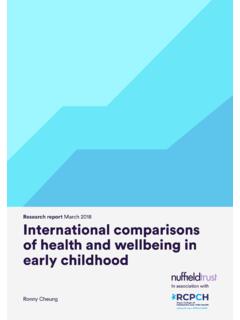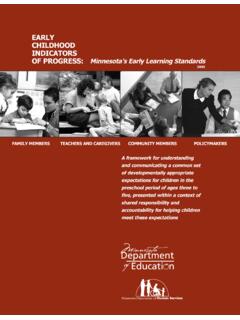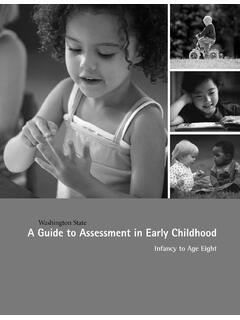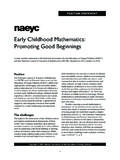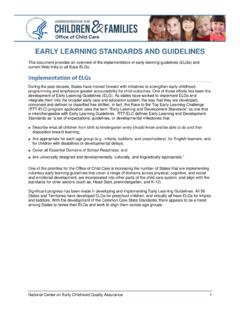Transcription of Quality: What it Is and Why it Matters in Early Childhood ...
1 Executive SummaryWhat does the term quality mean to you? Is it the difference between a one-star and a five-star hotel? A positive product review in Consumer Reports? Or durability that will last a lifetime? Experts in the field of Early care and education1 talk about program qual-ity but what does that look like? And why does it matter?This policy brief explains why quality Matters , demonstrates what quality looks like, and details how it should be measured. Finally, it posits this recommendation:New York State should invest in increased access to high-quality Early care and education programs. Targeted investment in high-quality Early care and education will improve school success in New York s most at-risk communities. Seventy-five percent of brain growth and 85% of intellect, personality and social skills develop before age five in the first 2,000 days of life so it is imperative that we invest in our youngest children long before they enter school.
2 2, 3 Yet we know that one out of three children in New York State start Kindergarten already behind in basic Early care and education programs serve children from infancy to age five in a variety of settings child care centers; family child care homes; Prekindergarten (Pre-K) and Head Start classes. In New York State, these programs serve more than 300,000 children every year. Thousands more are served in legally-exempt (non-regulated family, friend and neighbor) home-based child care and private nursery schools. All care, regardless of setting, should be affordable, acces-sible, and most importantly Quality IssueThe National Institute of Child Health and Devel-opment (NICHD) conducted a review from 1991 2007 that followed more than a thousand children from infancy through ninth grade, evaluating the impact that child care had on their The study also looked at family features, such as income and education level, with the understanding that all of these aspects affect a child s development.
3 According to the study, about half of children were found to receive moderate or highly positive care, while the other half did not. Children from poor fami-lies (who often had the highest need) tended to receive lower-quality care, except when they attended subsi-dized centers with better educated and trained staff. When research tells us that quality Early care and education can help close the achievement gap, why are we continuing to provide substandard child care and Early education to young children as they prepare for school and for life?Why Quality MattersPerhaps we think that if an Early care and educa-tion program isn t of the highest quality, it isn t the worst thing in the world. At least it isn t detrimental to a child s development right? Wrong!A child s readiness for school depends on meeting his/her comprehensive needs, which includes: physical and motor development; language and literacy; social and emotional development; approaches to learning; and cognitive development.
4 If a child enters school with deficits in these areas, it will be difficult to catch up. In fact, as much as half of school failure may be Quality: What it Is and Why it Mattersin Early Childhood Educationqual i tyMerriam Webster s Definition:2a : degree of excellence2b : superiority in kindSynonyms: caliber, class, grade, rate September 2012 Quality: What it Is and Why it Matters in Early Childhood Educationattributable to gaps in Early care and development that existed before school A child who starts behind is likely to stay shows that high-quality, intensive Early care and education programs for low-income children can have lasting positive effects such as greater school success, higher graduation rates, lower juvenile crime, decreased need for special education services later, and lower adolescent pregnancy rates. At the same time, low-quality care can have harmful effects on language, social development, and school performance that are more difficult to ameliorate, especially for children in schools with fewer resources.
5 The positive effects from high-quality programs and the negative effects from poor-quality programs are magnified for children from disadvantaged situations or with special needs, and yet these children are least likely to have access to quality Early care and education. Many fami-lies have no quality Early care and education options in their immediate shows that:Children who received higher-quality child care had better math skills prior to school entry and during kindergarten and second Toddlers who received higher-quality child care had fewer behavior problems than those who received lower-quality Children who received lower-quality child care during the first three years were rated more difficult by their preschool teachers and more hostile by their Kindergarten The NICHD study proved that the impact of quality (whether high or low) was long-lasting, with obedi-ence and academic problems persisting until age This study also showed that: Those who received higher-quality child care scored higher on tests gauging cognitive and academic achievement.
6 Teenagers who received higher-quality child care were less likely to engage in problem behaviors (fighting, arguing, being mean to others) than those who received lower-quality Quality Looks LikeSo what does quality look like? Parents, providers, and policymakers want to be able to visualize a qual-ity program. While they know that quality certainly doesn t entail a child sitting in front of a television set all day, they are often hard-pressed to define what it does look like. The National Association for the Education of Young Children (NAEYC) describes a high-quality pro-gram as providing a safe, nurturing environment that promotes the physical, social, emotional and cognitive development of young children while responding to the needs of families. Such a program depends greatly on the quality of the interactions between the child and the teacher. The First Five Years Fund s national Invest in US cam-paign, notes that you want to see teachers with four-year degrees and specific training in Early Childhood education; teachers who crouch to eye level to speak to children; teachers who hold, cuddle, show affec-tion and speak directly to infants and toddlers; and families and teachers exchanging information about the child s development and learning The interactive Invest in US exhibit provides an example of what a high-quality classroom looks like: of a high-quality program include: A developmentally appropriate curriculum; Adequate teacher training; A safe environment; Small group size and low adult to child ratios; and Parent-teacher communication (family engagement).
7 13 Schuyler Center for Analysis and Advocacy 3 How does this translate into practice? According to the National Association of Child Care Resource and Referral Agencies (NACCRRA), High-quality child care is a safe, clean and engaging place where parents can partner with trained profes-sionals in order to help nurture and develop their children intellectually, emotionally and physically. How Quality is MeasuredMeasuring quality can be challenging, but it is pos-sible. Quality indicators include process and structural measures. Process measures use standardized tools to mea-sure quality. The measure for classrooms serving infants and toddlers is called the Infant/Toddler Environment Rating Scale (ITERS); the measure for children ages three to five is the Early Childhood Envi-ronment Rating Scale (ECERS). The measure for child care provided in homes is the Family Day Care Rating Scale (FDCRS).
8 Each of the above scales has six subscales describ-ing specific features of a program:1. Space and furnishing2. Basic care routines3. Language development4. Social development5. Learning activities 6. Provisions for adult needsPossible ratings range from 1 to 7, with ratings from 1 to indi-cating poor care (do not meet basic custodial care needs), 3 to being minimal (meet basic care and safety needs), and 5 to 7 indicating good-to-excellent care (provides develop-mentally appropriate, personalized care, and has good materials for children s use).14 Structural measures examine caregiver characteristics (such as education and training), adult to child ratios, and class size. Another important measure of a high-quality learning environment is positive teacher-child interactions. The Classroom Assessment Scoring Sys-tem ( ) is an observational assessment that evaluates three domains of teacher-child interactions: emotional support, classroom orga-nization, and instructional support.
9 The Workforce is the Key to Quality A program cannot provide quality care if its staff does not know how to provide it. It takes a special person to work with children every day. While that person should like children, that is not the only requirement. New York State s Core Body of Knowledge outlines the six core competencies, or recommended practices, for Early Childhood The competencies are designed to help program leaders avoid a one-size-fits-all approach to professional development, concentrating instead on developmentally appropriate and individualized learning. The competencies are:1. Child Growth and Development2. Family and Community Relationships3. Observation and Assessment4. Environment and Curriculum5. Health, Safety, and Nutrition6. Professionalism and Leadership7. Administration and ManagementStudies show that infants have better expressive language skills when their caregivers are better edu-cated and that preschoolers language comprehension skills are higher when their caregivers have at least an Associate of Arts degree in a child-related , although a career ladder is currently under development, there is not yet one in place for the Early care and education workforce, and no incentive to pursue higher educa-tion.
10 The median salary for a child care worker with more than 20 years experience is $35,000 only slightly higher than a pizza deliv-ery person ($30,000, 5 9 years experience) and significantly less than a dog walker ($60,000, 5 9 years experience).17 Until the State makes an investment, we will continue to see an undereducated, or an overeducated and underpaid, workforce. And our children will suffer for Quality: What it Is and Why it Matters in Early Childhood EducationA Three-Pronged Approach: Access, Affordability and QualityUnfortunately, access and affordability are issues for families. For example, while New York State s Universal Pre-K program is free to families, it still only serves less than half of all eligible four-year-olds. This is because funding is not available to serve all eligible children. In addition, the State only funds part-day programs and does not provide transportation to and from those programs, making it difficult for work-ing parents to utilize them.
